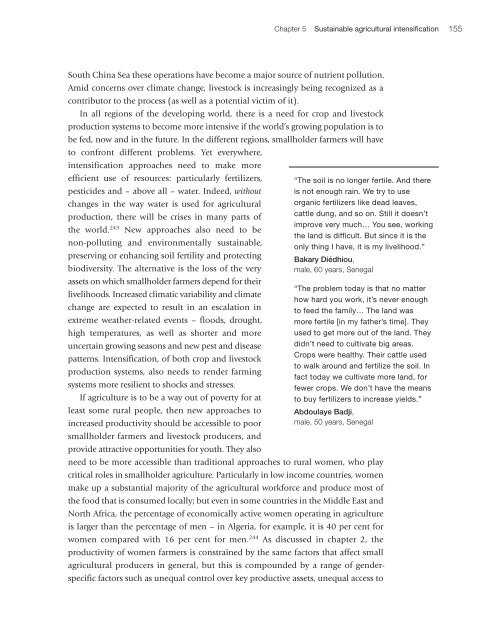English - IFAD
English - IFAD
English - IFAD
Create successful ePaper yourself
Turn your PDF publications into a flip-book with our unique Google optimized e-Paper software.
Chapter 5 Sustainable agricultural intensification 155<br />
South China Sea these operations have become a major source of nutrient pollution.<br />
Amid concerns over climate change, livestock is increasingly being recognized as a<br />
contributor to the process (as well as a potential victim of it).<br />
In all regions of the developing world, there is a need for crop and livestock<br />
production systems to become more intensive if the world’s growing population is to<br />
be fed, now and in the future. In the different regions, smallholder farmers will have<br />
to confront different problems. Yet everywhere,<br />
intensification approaches need to make more<br />
efficient use of resources: particularly fertilizers,<br />
pesticides and – above all – water. Indeed, without<br />
changes in the way water is used for agricultural<br />
production, there will be crises in many parts of<br />
the world. 243 New approaches also need to be<br />
non-polluting and environmentally sustainable,<br />
preserving or enhancing soil fertility and protecting<br />
Bakary Diédhiou,<br />
biodiversity. The alternative is the loss of the very male, 60 years, Senegal<br />
assets on which smallholder farmers depend for their<br />
livelihoods. Increased climatic variability and climate<br />
change are expected to result in an escalation in<br />
extreme weather-related events – floods, drought,<br />
high temperatures, as well as shorter and more<br />
uncertain growing seasons and new pest and disease<br />
patterns. Intensification, of both crop and livestock<br />
production systems, also needs to render farming<br />
systems more resilient to shocks and stresses.<br />
If agriculture is to be a way out of poverty for at<br />
least some rural people, then new approaches to Abdoulaye Badji,<br />
increased productivity should be accessible to poor male, 50 years, Senegal<br />
smallholder farmers and livestock producers, and<br />
provide attractive opportunities for youth. They also<br />
need to be more accessible than traditional approaches to rural women, who play<br />
critical roles in smallholder agriculture. Particularly in low income countries, women<br />
make up a substantial majority of the agricultural workforce and produce most of<br />
the food that is consumed locally; but even in some countries in the Middle East and<br />
North Africa, the percentage of economically active women operating in agriculture<br />
is larger than the percentage of men – in Algeria, for example, it is 40 per cent for<br />
women compared with 16 per cent for men. 244 As discussed in chapter 2, the<br />
productivity of women farmers is constrained by the same factors that affect small<br />
agricultural producers in general, but this is compounded by a range of genderspecific<br />
factors such as unequal control over key productive assets, unequal access to<br />
“The soil is no longer fertile. And there<br />
is not enough rain. We try to use<br />
organic fertilizers like dead leaves,<br />
cattle dung, and so on. Still it doesn’t<br />
improve very much… You see, working<br />
the land is difficult. But since it is the<br />
only thing I have, it is my livelihood.”<br />
“The problem today is that no matter<br />
how hard you work, it’s never enough<br />
to feed the family… The land was<br />
more fertile [in my father’s time]. They<br />
used to get more out of the land. They<br />
didn’t need to cultivate big areas.<br />
Crops were healthy. Their cattle used<br />
to walk around and fertilize the soil. In<br />
fact today we cultivate more land, for<br />
fewer crops. We don’t have the means<br />
to buy fertilizers to increase yields.”

















